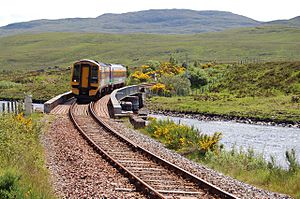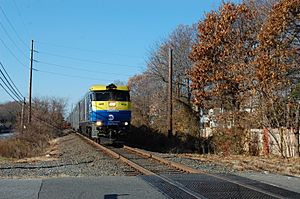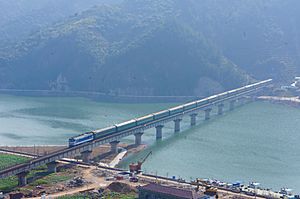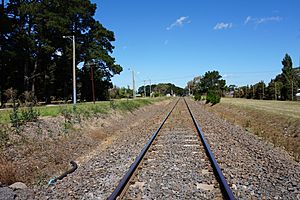Single-track railway facts for kids



A single-track railway is a type of railway where trains going in both directions use the same set of tracks. You usually find single tracks on train lines that are not used very often. These are often branch lines, which are smaller lines that connect to a main railway. Building and keeping up a single track costs less money than building a double track. This is why they are chosen when there isn't enough train traffic to need two tracks.
Contents
Why use single tracks?
Single tracks are much cheaper to build and take care of. However, they have some downsides when it comes to how many trains can run and how safe they are.
What are the challenges of single tracks?
- Fewer trains: Imagine a single-track line that takes 15 minutes to travel from one end to the other. Only two trains can safely go in each direction every hour. On the other hand, a double track with signals placed every four minutes can let up to 15 trains go in each direction every hour. This is if all trains travel at the same speed.
- Delays spread easily: If one train is late on a single track, it will also make any other train waiting for it to pass late. This can cause a chain reaction of delays.
- No backup track: A single track does not have a "reserve" or extra track. This means if the track is closed for any reason, no trains can run on that part of the line. A double track might still allow some trains to run on the other track.
- Long freight trains: Very long freight trains can be a problem if the places where trains can pass each other are not long enough to hold them.
How do single tracks work?
To make single-track lines work well, especially when more than one train uses them, special systems are needed.
What are passing loops?
If a single-track line needs to be used by more than one train at a time, it must have passing loops. These are also called passing sidings or crossing loops. They are short sections of double track found at different spots along the line. They allow trains going in opposite directions to pass each other. Usually, these loops are long enough to hold one train. The more passing loops a single-track line has, the more trains it can handle. Passing loops can also let faster trains overtake slower ones going in the same direction.
On some very quiet branch lines, like the Abbey Line in Great Britain, only one train is allowed on the line at a time. This is called "one train working" and means no passing loops are needed.
How do single tracks stay safe?
On single-track lines with passing loops, it's very important to make sure only one train uses a section of single track at a time. This prevents dangerous head-on collisions. A special signalling system is always needed.
- Token systems: In places like Great Britain, older single-track lines used a token system. A train driver had to have a special "token" to enter a section of single track. Since there was only one token for each section, only one train could be on it at a time. Some smaller lines still use this method. However, longer single-track lines in places like the Scottish Highlands now use radio communication, called Radio Electronic Token Block.
- Timetable and train orders: In early North American railways, trains often relied on a simple timetable. Operators knew when a train was supposed to be at a certain place. This system was improved with the telegraph, which allowed them to send train orders to adjust schedules.
Changing tracks: Doubling and singling
- Doubling: When a single-track railway is changed to a double track, it's called duplication or doubling.
- Singling: When a double track is changed to a single track, it's called singling.
- Single-line working: Sometimes, a double-track railway might only use one track for a period. This is known as single-line working.
For example, Kirkby railway station (until 1977) and Ormskirk railway station (until 1970) used to be double-track railways. They were later changed to single-track railways with a special setup called cross-platform interchange, where passengers can switch trains easily.
Bike paths and old railway lines
Sometimes, old railway lines are turned into bike paths. While this creates great places for biking and walking, it can also make it harder to use the corridor for trains again. If a bike path is built where a second track used to be, it limits the railway to a single track. It can also be difficult to remove the bike path later if trains are needed again, as bikers and hikers might not want to give it up. An example of this is the E&N Railway in Victoria, Canada.
Images for kids
See also
 In Spanish: Ferrocarril de vía única para niños
In Spanish: Ferrocarril de vía única para niños



